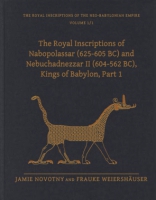
The Royal Inscriptions of Nabopolassar (625-605 BC) and Nebuchadnezzar II (604-562 BC), Kings of Babylon, Part 1
Jamie Novotny and Frauke Weiershäuser
The Royal Inscriptions of Nabopolassar (625-605 BC) and Nebuchadnezzar II (604-562 BC), Kings of Babylon, Part 1
Jamie Novotny and Frauke Weiershäuser
Nabopolassar was the first ruler of the Neo-Babylonian Empire. Rising to power from obscure origins, Nabopolassar defeated the Neo-Assyrians, who had controlled Babylonia for more than one hundred years. During the reign of Nabopolassar’s son, Nebuchadnezzar II, the Neo-Babylonian Empire developed into a major superpower. Best known for his ambitious building projects, including the famous Hanging Gardens of Babylon and the Ishtar Gate, Nebuchadnezzar also figures prominently in the Hebrew Bible as the king who destroyed Jerusalem and its temple, conquering Judah and inaugurating the Babylonian captivity.
- Description
- Bio
- Links
In this book, Jamie Novotny and Frauke Weiershäuser provide updated, reliable editions of seventy-one historical inscriptions of the Babylonian kings Nabopolassar and Nebuchadnezzar II, including nineteen never-before-published texts. Each text edition is accompanied by an English translation, a catalog of all exemplars, a comprehensive bibliography, and commentary containing notes and technical information. The volume also contains a general introduction to the reigns of these two rulers, the corpus of inscriptions, previous studies, and chronology; translations of the relevant passages of several Mesopotamian chronicles and king lists; photographs of objects; and indexes of museum and excavation numbers, selected publications, and proper names.
Featuring meticulous transliterations and translations that have been carefully collated with the originals, this book will be the standard edition for scholars and students of Assyriology, the Neo-Babylonian dialect, and the Neo-Babylonian Empire for decades to come.
Jamie Novotny is Tenured Academic Researcher of the Alexander von Humboldt Professorship for the Ancient History of the Near and Middle East at Ludwig-Maximilians-Universität München, Codirector of the Munich Open-Access Cuneiform Corpus Initiative, and Editor-in-Chief of the RINBE project. He is the author, editor, or coauthor of several books, including The Royal Inscriptions of Ashurbanipal (668–631 BC), Aššur-etel-ilāni (630–627 BC), and Sîn-šarra-iškun (626–612 BC), Kings of Assyria, Parts 1–3, also published by Eisenbrauns.
Frauke Weiershäuser is Tenured Academic Researcher of the Alexander von Humboldt Professorship for the Ancient History of the Near and Middle East at Ludwig-Maximilians-Universität München. She is the author of Die königlichen Frauen der III. Dynastie von Ur and The Royal Inscriptions of Amēl-Marduk (561–560 BC), Neriglissar (559–556 BC), and Nabonidus (555–539 BC), Kings of Babylon, the latter also published by Eisenbrauns.
A freely accessible PDF of this book is available via Open Access LMU. Click here.
Annotated (linguistically tagged) and searchable digital editions of the inscriptions included in RINBE 2 (with English and German translations) are also accessible via the ‘Babylon 7’ sub-project of the Oracc-hosted Royal Inscriptions of Babylonia online (RIBo) Project. Click here.
Also of Interest
Mailing List
Subscribe to our mailing list and be notified about new titles, journals and catalogs.




